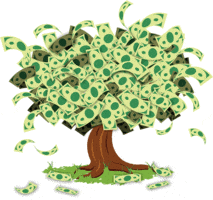Decimal, Fraction, Percentage Conversion Worksheets
As we move further along with math, we will learn that a value can be expressed using several different formats. A fraction displays the value that is normal less than a whole number. Fractions are expressed as the value (part) over the amount found in whole. Decimal values define the whole portion of the number and the fractional part separated by a decimal point. Percentages are expressed by displaying the value over the total (normally a total of 100). This unit will show us how to take the same value and communicate it in all three different formats. These worksheets and lessons show students how to convert between these three major forms of value notation.
Aligned Standard: 5.NBT.A.3
- Box Method Step-by-Step Lesson- We give you a decimal and you make it jump through hoops to become a fraction and percentage.
- Guided Lesson -
We start you on every different format of a number and you convert
it to all other forms.
- Guided Lesson Explanation - It did take me a while to figure out how best to explain this one.
- Convert Me 5 Pack - Start with a decimal and go in another direction with this one.
- Practice Worksheet - In retrospect, I should have used lines. A number of teachers have asked me to leave the lines off though.
- Matching Worksheet - These are direction-based conversions for a little twist.
- Decimals to Fractions Lesson and Practice - This is the hardest of the three skills covered here. I think it warranted its own lesson.
- Visualizing Shapes as Decimals and Fractions Worksheet - A nice way to introduce this or review it for that matter.
- Answer Keys - These are for all the unlocked materials above.
Homework Sheets
I like this format because you can quickly find any problems that students have with the material.
- Homework 1 - We will multiply the numerator and denominator by 100.
- Homework 2 - Convert a fraction to a percentage is to divide the numerator by the denominator. Then multiply the result by 100, and add the "%" sign.
- Homework 3 - To convert from percent to decimal: divide by 100, and remove the "%" sign.
Practice Worksheets
Similar to the homework, but a little more space to work with.
- Practice 1 - Write everything in the simplest form.
- Practice 2 - We can simplify this fraction further by finding a common factor.
- Practice 3 - To convert a fraction to a percentage, divide the numerator by the denominator.
Math Skill Quizzes
These really put students to the test and see if you have it down pat.
- Quiz 1 - These will put you to the test.
- Quiz 2 - See if you can find a quick way to complete these.
- Quiz 3 - What are you going to do here.
Converting Values Between Decimals, Fractions, and Percentages

A very important concept that students have to completely understand is how to express the same value as a decimal, fraction, and percentage. We often begin working on this skill by generating equivalent values. Equivalency means that we can use any of these to formats to display the same value. A fraction can be converted into a decimal as well as a percentage. A decimal can be converted into fraction and a percentage. A percentage can be converted into a decimal as well as a fraction.
Let's use 50% as an example here. We know that the "%" means "out of hundred." When we remove the "%" we can write 50% as 50/100. See this way we have converted the percentage in the form of a fraction. We further simplify the fraction and get 1/2. To convert this fraction into a decimal number we apply simple division (1/2) and get 0.5. We have taken a percentage as an example. Now if we want to convert 1/2 into a decimal number and a percentage. We apply simple division and get 0.5 and when we multiply the decimal number by 100, we get 50%. Now, if we take the decimal number 0.5 and wish to convert it into a fraction and a percentage, we remove the decimal and write it as 5/10 and when we further simplify it, we get 1/2. We can multiply 0.5 with 100 to convert the decimal number into a fraction.
While we can spin between these conversions all day, why don’t we lock down simple rules for converting values:
Percent to Decimal: Divide the percent by 100 and remove the % symbol.
Decimal to Percent: Multiply by 100 and add the % symbol.
Fraction to Decimal: Divide the top number (numerator) by the bottom number (denominator).
Decimal to Fraction: Multiply the decimal by 100. Place that value as the numerator over a denominator of 100. Reduce as needed.
Fraction to Percentage: Divide the top number (numerator) by the bottom number (denominator). Multiply that value by 100 and add the % symbol.
Percent to Fraction: Divide the percent by 100 and remove the % symbol. Multiply the decimal by 100. Place that value as the numerator over a denominator of 100. Reduce as needed.
We save the most complicated conversion for last. You will convert the value through a series of two conversions. See if you can determine the two-part path that we took to get that final value?